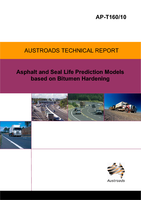Materials

- Publication no: AP-T160-10
- ISBN: 978-1-921709-22-7
- Published: 17 May 2010
- PDF (free) Download
This report documents the surface life prediction models that have evolved from the long term sampling of the bitumen in sprayed seals and thin asphalt surfaces. The estimation of surface life is predicated on the basis of the mechanism of bitumen hardening to a point where its viscosity causes brittleness and cracking of the bitumen. This mechanism is highly dependent on climatic conditions rather than traffic load and the underlying state of the pavement. The seal life model has had extensive development and includes a risk factor, R, to account for the consequences of delaying sealing past the first signs of surface distress. This model is based on a bitumen hardening model and a distress viscosity model which are dependent on climatic conditions. It can be applied to thin asphalt surfaces provided the percentage of air voids in the asphalt is known and the estimates of climatic conditions can be determined using the software tool noted above.
- AP-T160/10 Asphalt and Seal Life Prediction Models based on Bitumen Hardening
- CONTENTS
- TABLES
- FIGURES
- SUMMARY
- 1. INTRODUCTION
- 1.1. Background
- 1.2. Scope
- 2. SEAL LIFE MODEL FOR SPRAYED SEALS
- 2.1. Seal Life Model
- 2.2. Examples of Broad Estimates of Seal Lives
- 3. SURFACING L IFE MODEL FOR ASPHALT
- 3.1. Asphalt Surfacing Life Model
- 3.2. Comparison Between Predicted Seal and Asphalt Seal Lives
- 4. CONCLUSIONS
- 4.1. Seal Life Model
- 4.2. Asphalt Surfacing Model
- REFERENCES
- INFORMATION RETRIEVAL
